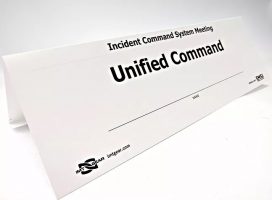The Incident Commander (IC) has overall authority and responsibility for managing all operations at the incident site. This individual(s) is/are responsible for all incident activities including the development of the objectives and strategies and the ordering and release of resources; therefore, it is essential that the selection of Incident Command style be taken very seriously. There are three specific ways to establish Incident Command: through a single IC, a single IC with Deputy(s) or Unified Command (UC). The most common way is through the use of a single IC. Here, the agency having jurisdiction over the incident elects to use only one IC. In the option of a single IC with Deputy(s), the agency having jurisdiction elects to have an IC from the lead agency preside over the incident while also using Deputy ICs from assisting agencies or departments.
UC is a team effort that allows all agencies with jurisdictional responsibility for an incident, either geographical or functional, to participate in incident management. This participation is demonstrated by developing and implementing a common set of incident objectives and strategies to which all agencies can subscribe, without losing or abdicating agency authority, responsibility, or accountability. UC can be used at: incidents that impact more than one political jurisdiction, incidents involving multiple agencies/departments within the same political jurisdiction, or incidents that impact/involve several political and functional agencies. Common features include a system that:
-
enables all agencies with responsibility to manage an incident together by establishing a common set of incident objectives and strategies,
-
creates a single planning process and incident action plan (IAP) allowing the UC to make joint decisions by establishing a single command structure, and
-
provides a single integrated incident organization, along with collocated (shared) facilities, an integrated general staff and unity of command.
Area Command is an incident organization established, when necessary, to provide overall command and authority for two or more events or incidents, usually in close proximity to one another. Area Command works closely with the ICs to establish overall objectives, priorities, management of critical resources, logistical concerns and planning issues. Area Command, when activated, should eliminate confusion by providing the necessary oversight to the incidents/events they are managing. The Area Command team should be made up of qualified and trained personnel in respect to their functions. The Area Command staff can consist of Area Commander, Area Command Logistics Chief (which also may have a Critical Resource Unit), Area Command Planning Chief (which also may have a Situation Unit Leader), as well as the Command staff positions of Liaison Officer and Information Officer. Remember, each of the above positions will require sufficient staff to assist in the completion of duties. Just as in ICS Command, staff personnel may have assistants and general staff positions may have deputies.
It is important to remember that Area Command does not in any way replace the incident level command organization or functions. Remember, the incidents will be managed by using ICS; therefore, they can be managed by a single IC, an IC with deputy ICs, or UC. The Area Command positions are established to enable ICs and their personnel to manage the incident, while Area Command assists them in meeting their objectives through: critical resource ordering and tracking, advance planning, and handling of logistical concerns.
Multi-Agency Coordinating Entities/Groups are an organizational structure used to coordinate resources and support between or among organizations. MAC Groups interact with organizations, not with incidents.
EOCs are used in varying ways at all levels of government (City, County, Region and/or State) and within private industry to provide coordination, support, direction, and control during emergencies. It is important to note that MACs and EOCs are not used for command and control of incident management but, as stated above, to support, coordinate and provide direction for incidents.
To read more about the author, Gary Seidel, click here!


